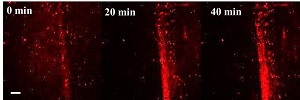 |
| Increasing bone density over time using self-powered nanomeds dyed with red fluorescence--Courtesy of Penn State |
Researchers at Penn State University and Boston University have developed self-powered nanoparticles to carry drugs into tiny cracks in bones, a process that could help treat osteoporosis in its early stages. And the fuel for the nanovehicles' bone-delving ability comes from the bone itself.
The scientists used the electrically charged minerals released from bone cracks to drive the nanoparticles forward quickly to where the drugs would be most useful inside the bone, according to Penn State University. As opposed to current methods, which deliver medications passively in the bloodstream, the novel treatment actively delivers the medications using the electric field created by these charged particles as an energy source. The team published their study in the international chemistry journal Angewandte Chemie.
In a series of tests, the researchers observed the nanoparticles' ability to pile up on a newly formed crack in a human bone. Then, by attaching the biological osteoporosis drug to the powered, synthetic nanoparticles, they were able to deliver a dose of medicine to the bone cells, as well as a fluorescent dye so they could see the results.
"What makes our nanomotors different is that they can actively and naturally deliver medications to a targeted area," said team co-leader Ayusman Sen. "Current methods, in contrast, involve taking a drug and hoping that enough of it gets to where it is needed for healing."
Furthermore, both the drug and the material that makes up the nanoparticle are FDA-approved, which brings the entire nanomed closer to the clinic. But it still needs further safety and efficacy tests before that becomes a reality, according to the report.
- here's the Penn State report
- get the research abstract